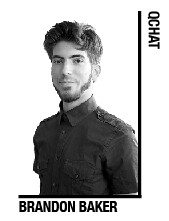 Columnist Brandon Baker asserts that GLBT bars don’t match their stigmas in society.
Columnist Brandon Baker asserts that GLBT bars don’t match their stigmas in society.
Philadelphia’s GLBT community is blessed with a variety of friendly – read: outrageous – bars to choose from, especially in a state that might have a measly one or two other bars of the like in its remaining cities. In fact, it seems Philadelphia shines as the bright beacon of hope for gays isolated in the “Pennsyltucky” areas of the state where dive bars and machismo sports bars are more likely to be encountered than bars with drag show extravaganzas and cosmopolitan drink specials. For a small-town gay, walking past the rainbow-colored street signs in the Gayborhood is like passing through New York Harbor and witnessing the Statue of Liberty.
Rejoice, Philly gays: You are free to drink in peace.
Yet I’ve noticed during my time in the city that there is a certain reaction to words like “iCandy” and “Voyeur” when going through the motions of a conversation with a straight person. From women, there is the standard uprising of joy as they consider that they can finally dance somewhere without being poked and prodded by curious, drunk male prospects on the dance floor. From men, however, I get the apprehensive reaction of an eyebrow raise and an awkward half smile.
Is there supposed to be something extraordinarily tawdry about gay bars that I’m missing, or is that just another made-up stigma attached because of the “gay” placed before the “bar”?
A long-ago faded part of me partially understands why the perception of gay bars can be a bit daunting. When I was a newly out teen curious about gay bars, I imagined a scene straight out of “Queer As Folk.” That is, a sinful, rowdy gathering of a city’s most attractive and energetic gays looking to get laid. The idea appeared both terrifying and titillating – but mostly titillating.
Imagine my surprise when I arrived in Philadelphia and observed that the reality wasn’t quite as extravagant as the fantasy. Not that I haven’t witnessed gay paradise in the bar scene, but I recall my first gay bar visit to be one that was rather underwhelming. Not because it was a bad experience, but because it felt markedly normal. I didn’t see any go-go dancers, the bartender had a shirt on, and the men standing next to me waiting for a drink were middle-aged and dressed age-appropriately.
“What the hell kind of gay bar Wonderland is this?” I remember thinking.
Curiously, it is not even so much that I wanted a “traditional” gay bar experience, I had just conceived a notion of what to expect at any and every bar packed with gay men and women. Maybe it was a small town prejudice, or maybe there really is a certain universal reputation attached to gay bars that just isn’t true.
There are certain aspects of the imaginary gay bar that, of course, do ring true. If you’re there by yourself, sitting on a bar stool cruising down every passing person, you’re probably looking to get it in. But then again, the same could be said of any bar, regardless of sexual orientation.
I may never understand the reasoning behind the exact logic of the heterosexual community in finding gay bars to be strictly effeminate places of promiscuity, but I would hope that heterosexual men in particular would at least experiment with going to a gay bar before giving me the uncomfortable eyebrow raise upon mentioning one in conversation.
Regardless of the stigmas and the sometimes crude reputation, there remains something blissful about the gay bar experience that, in a way, could be likened to the thriving social scenes of the Harlem Renaissance.
I’m not, by any stretch of the imagination, claiming gay bars are providers of art in the same transformative way Harlem was, but there is a certain cultural experience to be had that can be enjoyed by all people. Harlem became known for attracting diverse crowds, after all.
Perhaps the GLBT community just needs its own version of Harlem to communicate that much-needed message of all-inclusiveness, and perhaps one day Philadelphia’s Gayborhood can and will be that cultural center.
Brandon Baker can be reached at brandon.baker@temple.edu.



What are you doing!!? We need our bars’ seedy reputations. Str8s are already feeling a bit too comfortable coming into our now very ‘hip’ establishments. Increasingly there are nights when we are outnumbered and crowded off our own dancefloors by our female ‘fans’. They’ve even started to bring along their str8 boyfrienda. Soon, str8 guys are going to realize where all the hot women are hanging out, and without the stigma they associate with us and our bars, we’ll be dealing with them too.
So shhhhhhhhhhhhhhhhh..! for cryin’ out loud…